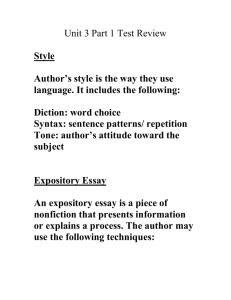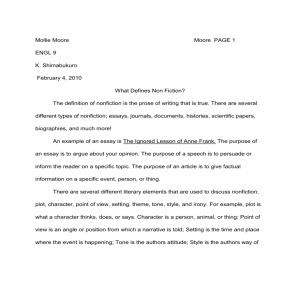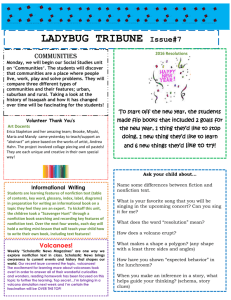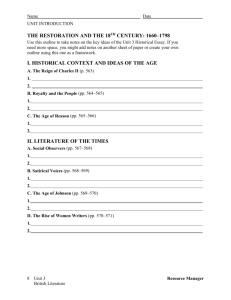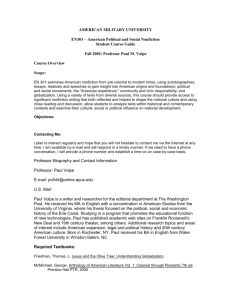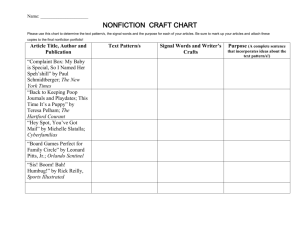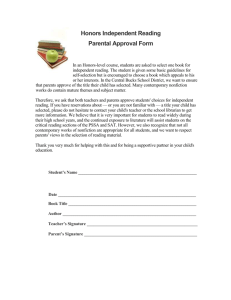Reading Non-Fiction Texts
advertisement
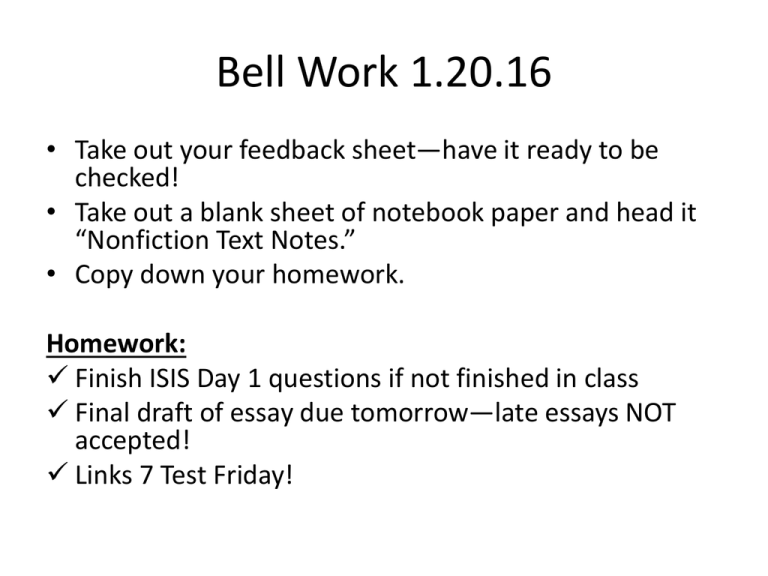
Bell Work 1.20.16 • Take out your feedback sheet—have it ready to be checked! • Take out a blank sheet of notebook paper and head it “Nonfiction Text Notes.” • Copy down your homework. Homework: Finish ISIS Day 1 questions if not finished in class Final draft of essay due tomorrow—late essays NOT accepted! Links 7 Test Friday! Reading Non-Fiction Texts Elements of Nonfiction • Focuses on real people • Describes true events and conflicts • Is narrated from the point of view/perspective of the author, who is a real person • Presents facts or discusses ideas related to real places and historical periods • Conveys a central idea supported by details Forms of Nonfiction • Literary nonfiction—has elements of fiction – vivid descriptions, a dramatic writing style, or poetic language – Examples: biographies, autobiographies, memoirs, letters, essays, articles, reviews, reports **For more detailed information, see pg. 5 in your textbook Forms of Nonfiction • Functional Texts—texts that give instructions, show directions, explain rules, or provide other types of information that help you complete procedures – Often include illustrations or graphics to help guide the reader – Examples: recipes, directions, schedules, menus, brochures, maps, applications *For more detailed information, see pg. 5 in textbook Central Idea and Author Purpose • Just like works of fiction have a theme, works of nonfiction have a central, or main, idea • Author’s purpose—his or her main reason for writing – Three most common purposes: entertain, inform, or persuade – An author may have more than one purpose in a single work Nonfiction Text Structure • To fulfill his/her purpose, the writer organizes information in a logical structure • Chronological—presenting events in the order in which they happened (time order) • Spatial—describes items as they appear in space (left to right) Nonfiction Text Structure (continued) • Comparison and contrast—groups ideas based on their similarities and differences • Cause and effect—explains how one event causes or leads to another • Problem and solution—examines a problem and proposes ways to solve it Nonfiction Text Features • Headings and subheadings—breaks the text into different topics • Pictures, graphs, tables, etc.—provides additional information usually not written in the body of the text BW 1.21.16 • Take out your Paired Passage Essay Final Draft • Take out your rough draft and essay outline • Staple these items together in this order: – First page: outline – Second page: rough draft – Third page: final draft • Take out a blank sheet of notebook paper and a blue textbook from under your desk Homework: Finish Day 2 ISIS questions if not finished in class Study Links 7 for test tomorrow! Nonfiction Test-Prep Practice • Turn to page 153 in your textbook. • Read the short passage. • Answer questions 1-4 on your own sheet of notebook paper Nonfiction Test-Prep Practice 2 • Turn to page 461 in your literature textbook • Read the short passage. • Answer questions 1-4 on your own sheet of notebook paper BW 1.22.16 • • • • Take out your ISIS Day 1 and Day 2 questions Make sure your name is on them. Staple them together and put them in the basket Take out your Links sheet 7. – Make sure it is complete and take some time to study! Homework: Finish questions for the Nancy Lambert article if not finished in class. After Test… • Turn in your test to the gray table at the front of the room. • Pick up a Nancy Lambert Article and question sheet • Read the article quietly and complete the questions independently. • Do your BEST work and write in COMPLETE sentences!
